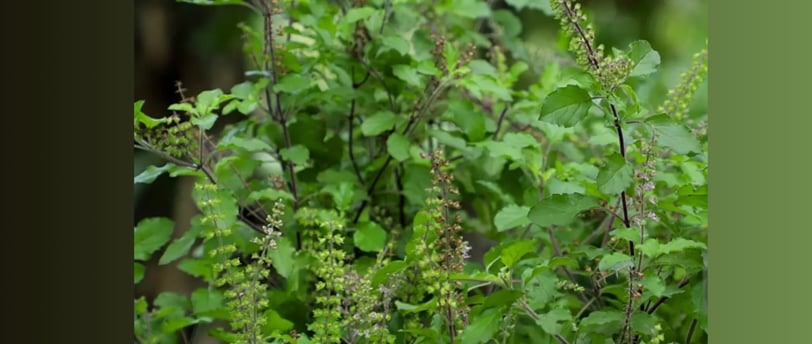Krishna Tulsi
Known for a strong clove-like scent; valued in Ayurveda
6/25/20252 min read


Tulsi or Tulasi (Ocimum tenuiflorum) or Holy basil is a sacred plant in Hindu belief. Hindus regard it as an earthly manifestation of the goddess Tulsi; she is regarded as a great worshipper of the god Vishnu. The offering of its leaves is mandatory in ritualistic worship of Vishnu and his forms like Krishna and Vithoba.
Many Hindus have tulsi plants growing in front of or near their home, often in special pots or a special masonry structure known as Tulsi Vrindavan. Traditionally, Tulsi is planted in the center of the central courtyard of Hindu houses. The plant is cultivated for religious and medicinal purposes, and for its essential oil.
Also known as 'Krishna or Shyama Tulsi', the Purple leaf tulsi is famous for its peppery, crisp taste. It comprises purple colored leaves and dark stems. Although, it is grown in many regions in India, it is relatively more difficult to find than the green varietals. Purple leaf Tulsi is known to be beneficial to treat throat infection
It is known as Holy Basil in English and Tulasi in Sanskrit. Other names used for the Tulsi are Manjari, Krishna Tulsi, Trittavu, Tulshi and Thulsi.
Tulsi is one of roughly 60 species of the genus Ocimum, the basil genus. Within the Tulsi family, there are several kinds grown in India. Most varieties are native to India, including the foothills of the Himalayas; they are also found throughout the Middle East.
Tulsi is grown as an annual herb in temperate climates that may grow to a height of three feet. The root grows as a branched taproot. The stem has a square or quadrangular shape characteristic to Lamiaceae plants, and is branched, green to red in color with a fine layer of pubescence. The leaves are opposite, simple, ovate, serrate and petiolate.
The flowers grow in a verticillaster inflorescence and are complete with a blue to purple color.
There are four types of tulsi mentioned in ayurvedic texts
Although, all three types of Tulsi have their uses in ayurveda, the Rama and Krishna are the most widely used.
Purple Leaf Tulsi,
Also known as 'Krishna or Shyama Tulsi', the Purple leaf tulsi is famous for its peppery, crisp taste. It comprises purple colored leaves and dark stems.
Although, it is grown in many regions in India, it is relatively more difficult to find than the green vaiietals. Purple leaf Tulsi is known to be beneficial to treat throat infections, respirtory system, nasal lesions, earache and skin diseases.
Medicinal uses
Tulsi is taken as the herbal tea.
The oil extracted from the Karpoora Tulsi is mostly used in the herbal toiletry. Its oil is also used against the insects and bacteria.
The Rama Tulsi is the effective remedy for the Severe acute Respiratory Syndrome. Juice of its leaves gives relief in cold, fever, bronchitis and
cough. Tulsi oil is also used as the ear drop.
Tulsi helps in curing malaria.
It si very effective against indigestion, headache, hysteria, insomnia and cholera.
The fresh leaves of Tulsi are taken by the million of people everyday.
Tulsi has got the great medicinal value. For over the centuries Tulsi (the queen of herbs) has been known for its remarkable healing properties.
Krishna Tulsi
Souparnika Green Herb Oil
EPR Ayurvedhic
Kuruvilasseri , Valiyaparambu
Thrissur , Kerala - 680732
Contact
eprayurvedics@gmail.com
+91 7356774405 | +91 9048627017
EPR ayurvedhic © 2025. All rights reserved.
Our IT Partner | Nibhas IT Solutions
